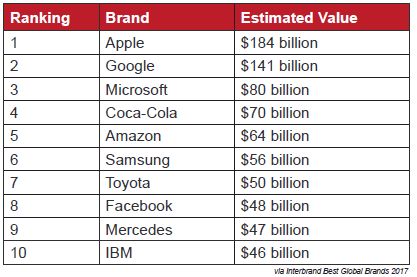According to Interbrand's 2017 Best Global Brands, the Apple® brand is valued at $184 billion dollars. And the top 10 brands hold 45 percent of the best global brands overall value with a combined value of $785 billion. Id. The chart below highlights the significance of brand value:

The numbers are astonishing, but what do they mean? And how is brand value related to trademark goodwill? Are the two interchangeable? And what should you be doing to protect the goodwill associated with trademarks?
Trademarks and Goodwill
Trademarks are a source identifier – they designate a single source of a product or service. Trademarks can be a word, symbol, design, color, sound or smell, and are a legal concept. The Lanham Act defines a trademark as "any word, name, symbol, or device, or any combination thereof, used in commerce to identify and distinguish the goods of one manufacturer or seller from those of another and to indicate the source of the goods." 15 U.S.C. § 1127. A brand, on the other hand, is not a legal term of art and tends to be broader in concept. A brand does not necessarily refer to a single product, but rather can refer to a portfolio of brands, sub-brands and more associated with a company, such as domain names, social media presence, advertising and more. So the "brand value," including the figures noted above, goes beyond a single product or service offering.
"Goodwill" also refers to value, but is tied to a particular trademark. Trademarks associated with higher quality products tend to enjoy more goodwill. The difficulty lies in determining the value of goodwill. Although Interbrand has developed its own methodology for determining the value tied to a particular brand, valuation of intangible assets such as trademarks, is an imperfect science and can be difficult to do. Certain accounting principles provide that "goodwill" in a company, including its trademarks, is determined by taking the difference between the total market value of a company and the value of its hard assets. As far as individual trademark goodwill valuation, different methods are available and have been used in litigation, licensing and other contexts. These valuation methods include a cost valuation for each individual trademark, income expected to be generated by a trademark, or market value.
Regardless of the valuation methodology used, trademark owners do have control over the value of the goodwill associated with a particular trademark, and such control starts at inception of the trademark. Trademark owners can and should select a conceptually strong mark (i.e., one that is suggestive, arbitrary or fanciful) and should avoid generic or descriptive marks. In addition to a conceptually strong mark, trademark owners should adopt a commercially strong mark (i.e., one that is not commonly used in the industry) and one that may allow for expansion to other product and service categories down the road. These pre-adoption considerations will help ensure strong value and goodwill in the marketplace.
How Does Goodwill Affect Trademark Licensing, Enforcement and Litigation?
Certainly the value of the goodwill associated with a trademark has a direct impact on licensing, enforcement efforts and litigation. The stronger the brand, the more likely it is to open doors for licensing opportunities, which may include opening new markets to the trademark owner. In addition, the value of the goodwill associated with the trademark will provide the trademark owner with leverage during license negotiations, which can lead to stronger royalty rates for the trademark owner.
From an enforcement perspective, the goodwill associated with a particular trademark will help to broaden the scope of enforcement efforts and give additional credence to demand letters and other enforcement efforts. It will also carry significant weight with a court and the Trademark Trial and Appeal Board for litigation proceedings.
What Should Trademark Owners Do to Protect Goodwill and Reputational Damage?
Like any assets, trademark owners need to protect trademarks in order to preserve (and generate) goodwill. A key way trademark owners can protect the goodwill associated with trademarks is by establishing a strong enforcement program. In fact, trademark owners have a duty to police infringing uses, therefore instituting a strong enforcement plan at the early stages of adopting a trademark is critical. The enforcement program should clearly define the scope of the client's rights and prioritize infringement and other issues associated with third-party unauthorized use of a trademark.
Some key steps for protecting the goodwill associated with a trademark include:
- Subscribe to a watch service and use other means for identifying infringing, improper and unauthorized uses of your trademarks;
- Prioritize and take action against infringing, unauthorized and improper uses of the trademark;
- Maintain records of the enforcement efforts;
- When necessary, file suit to preserve rights and to establish a precedent for proactively protecting rights in order to deter future infringers; and
- Include strong quality control provisions in license agreements and set up an internal program for checks of how licensees are using the licensed trademark.
Additional steps for protecting trademarks and the associated goodwill include evaluating coverage in key international jurisdictions and recording trademarks with local customs authorities.
Finally, should a company experience reputational damage based on a particular product, it's also worth considering whether the company's overall brand reputation can be used to help rehabilitate the reputation for a single trademark. Conversely, it's also worth considering the impact a problematic product or service may have on a brand's overall reputation. Should the company consider abandoning a particular trademark in order to preserve the goodwill associated with the company's overall brand or by rebranding the product?
The above are some high-level thoughts on goodwill and proactive steps a trademark owner can take to preserve – and expand – the goodwill associated with a trademark.
The content of this article is intended to provide a general guide to the subject matter. Specialist advice should be sought about your specific circumstances.

